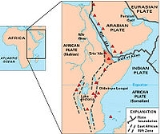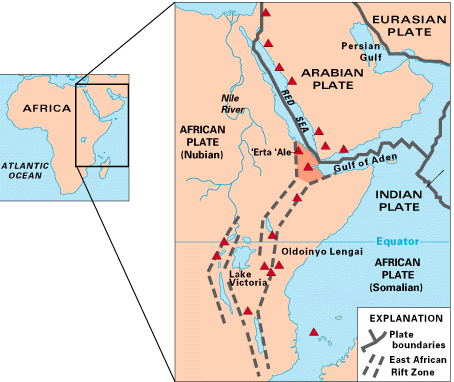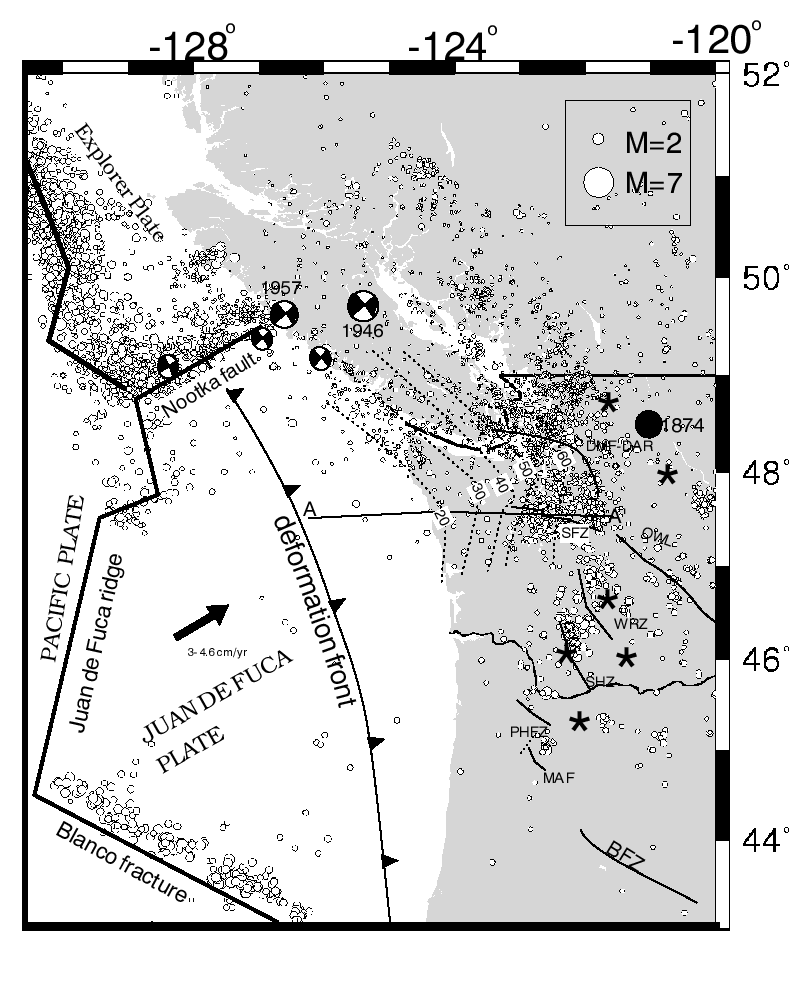
Triple junction
Encyclopedia
A triple junction is the point where the boundaries of three tectonic plates meet. At the triple junction a boundary will be one of 3 types - a ridge
, trench
or transform fault
- and triple junctions can be described according to the types of plate margin that meet at them. Of the many possible types of triple junction only a few are stable
through time ('stable' in this context means that the geometrical configuration of the triple junction will not change through time).
, Dan McKenzie, and Tanya Atwater
. The term has traditionally been used for the intersection of three divergent boundaries or spreading ridges. These three divergent boundaries ideally meet at near 120° angles.
In plate tectonics
theory during the breakup of a continent, one of the divergent plate boundaries would fail (see aulacogen
) and the other two would continue spreading to form an ocean. The opening
of the south Atlantic Ocean
started at the south of the South America
n and African continents, reaching a triple junction in the present Gulf of Guinea
, from where it continued to the west. The NE-trending Benue Trough
is the failed arm of this junction.


Mid-ocean ridge
A mid-ocean ridge is a general term for an underwater mountain system that consists of various mountain ranges , typically having a valley known as a rift running along its spine, formed by plate tectonics. This type of oceanic ridge is characteristic of what is known as an oceanic spreading...
, trench
Oceanic trench
The oceanic trenches are hemispheric-scale long but narrow topographic depressions of the sea floor. They are also the deepest parts of the ocean floor....
or transform fault
Transform fault
A transform fault or transform boundary, also known as conservative plate boundary since these faults neither create nor destroy lithosphere, is a type of fault whose relative motion is predominantly horizontal in either sinistral or dextral direction. Furthermore, transform faults end abruptly...
- and triple junctions can be described according to the types of plate margin that meet at them. Of the many possible types of triple junction only a few are stable
Triple junction stability
Triple junction stability is a term used in geology. A triple junction is the point at which three plate boundaries meet. These boundaries can either be ridges , trenches or transform faults . Triple junctions were once defined simply as the meeting point of three spreading ridges...
through time ('stable' in this context means that the geometrical configuration of the triple junction will not change through time).
History
The first scientific paper detailing the triple junction concept was published in 1969 by W. Jason MorganW. Jason Morgan
William Jason Morgan is an American geophysicist who has made seminal contributions to the theory of plate tectonics and geodynamics...
, Dan McKenzie, and Tanya Atwater
Tanya Atwater
Tanya Atwater is an American geophysicist and marine geologist who specializes in plate tectonics, in particular the evolution of the San Andreas fault plate boundary. Her educational work has focused on the creation of computer-animated multimedia products and presentations depicting plate...
. The term has traditionally been used for the intersection of three divergent boundaries or spreading ridges. These three divergent boundaries ideally meet at near 120° angles.
In plate tectonics
Plate tectonics
Plate tectonics is a scientific theory that describes the large scale motions of Earth's lithosphere...
theory during the breakup of a continent, one of the divergent plate boundaries would fail (see aulacogen
Aulacogen
In geology, an aulacogen is a failed arm of a triple junction of a plate tectonics rift system. A triple junction beneath a continental plate initiates a three way breakup of the continental plate. As the continental break-up develops one of the three spreading ridges typically fails or stops...
) and the other two would continue spreading to form an ocean. The opening
Seafloor spreading
Seafloor spreading is a process that occurs at mid-ocean ridges, where new oceanic crust is formed through volcanic activity and then gradually moves away from the ridge. Seafloor spreading helps explain continental drift in the theory of plate tectonics....
of the south Atlantic Ocean
Atlantic Ocean
The Atlantic Ocean is the second-largest of the world's oceanic divisions. With a total area of about , it covers approximately 20% of the Earth's surface and about 26% of its water surface area...
started at the south of the South America
South America
South America is a continent situated in the Western Hemisphere, mostly in the Southern Hemisphere, with a relatively small portion in the Northern Hemisphere. The continent is also considered a subcontinent of the Americas. It is bordered on the west by the Pacific Ocean and on the north and east...
n and African continents, reaching a triple junction in the present Gulf of Guinea
Gulf of Guinea
The Gulf of Guinea is the northeasternmost part of the tropical Atlantic Ocean between Cape Lopez in Gabon, north and west to Cape Palmas in Liberia. The intersection of the Equator and Prime Meridian is in the gulf....
, from where it continued to the west. The NE-trending Benue Trough
Benue Trough
The Benue Trough is a major geological formation underlying a large part of Nigeria and extending about 1,000 km northeast from the Bight of Benin to Lake Chad.It is part of the broader Central African Rift System.-Location:...
is the failed arm of this junction.
Examples


- The junction of the Red SeaRed SeaThe Red Sea is a seawater inlet of the Indian Ocean, lying between Africa and Asia. The connection to the ocean is in the south through the Bab el Mandeb strait and the Gulf of Aden. In the north, there is the Sinai Peninsula, the Gulf of Aqaba, and the Gulf of Suez...
, the Gulf of AdenGulf of AdenThe Gulf of Aden is located in the Arabian Sea between Yemen, on the south coast of the Arabian Peninsula, and Somalia in the Horn of Africa. In the northwest, it connects with the Red Sea through the Bab-el-Mandeb strait, which is about 20 miles wide....
and the East African RiftEast African RiftThe East African Rift is an active continental rift zone in eastern Africa that appears to be a developing divergent tectonic plate boundary. It is part of the larger Great Rift Valley. The rift is a narrow zone in which the African Plate is in the process of splitting into two new tectonic plates...
centered in the Afar Triangle is an example of a triple junction (the Afar Triple JunctionAfar Triple JunctionThe Afar Triple Junction is a junction of three tectonic rifts centered in the Afar Depression, informally known as the Afar Triangle, of northeastern Africa. Here, the Red Sea Rift meets the Aden Ridge and the East African Rift...
). This is the only Ridge-Ridge-Ridge (R-R-R) triple junction above sea level. - Another example of a triple junction is the junction between the Arabian PlateArabian PlateThe Arabian Plate is one of three tectonic plates which have been moving northward over millions of years and colliding with the Eurasian Plate...
, the African PlateAfrican PlateThe African Plate is a tectonic plate which includes the continent of Africa, as well as oceanic crust which lies between the continent and various surrounding ocean ridges.-Boundaries:...
, and the Indo-Australian PlateIndo-Australian PlateThe Indo-Australian Plate is a major tectonic plate that includes the continent of Australia and surrounding ocean, and extends northwest to include the Indian subcontinent and adjacent waters...
. - Another active example is the Galapagos Triple JunctionGalapagos Triple JunctionThe Galapagos Triple Junction is a geological area in the eastern Pacific Ocean several hundred miles west of the Galapagos Islands where three tectonic plates - the Cocos Plate, the Nazca Plate and the Pacific Plate - meet. It is an unusual type of triple junction in which the three plates do not...
, an R-R-R triple junction where the NazcaNazca Plate]The Nazca Plate, named after the Nazca region of southern Peru, is an oceanic tectonic plate in the eastern Pacific Ocean basin off the west coast of South America. The ongoing subduction along the Peru-Chile Trench of the Nazca Plate under the South American Plate is largely responsible for the...
, the CocosCocos PlateThe Cocos Plate is an oceanic tectonic plate beneath the Pacific Ocean off the west coast of Central America, named for Cocos Island, which rides upon it.-Geology:...
, and the Pacific PlatePacific PlateThe Pacific Plate is an oceanic tectonic plate that lies beneath the Pacific Ocean. At 103 million square kilometres, it is the largest tectonic plate....
s meet. The East Pacific RiseEast Pacific RiseThe East Pacific Rise is a mid-oceanic ridge, a divergent tectonic plate boundary located along the floor of the Pacific Ocean. It separates the Pacific Plate to the west from the North American Plate, the Rivera Plate, the Cocos Plate, the Nazca Plate, and the Antarctic Plate...
extends north and south from this junction and the Galapagos RiseGalapagos RiseThe Galapagos Rise is a divergent boundary located between the South American coast and the triple junction of the Nazca Plate, the Cocos Plate, and the Pacific Plate. The volcanically active Galapagos Islands exist on the Galápagos hotspot above the Galapagos Rise...
goes to the east. This example is made more complex by the Galapagos MicroplateGalapagos MicroplateThe Galapagos Microplate is a small tectonic plate off the west coast of South America near the Galapagos Islands. It differs from most other crustal plates in that it is rotating clockwise between three much larger crustal plates around it, the Nazca, Cocos and Pacific Plates...
which is a small separate plate on the rise just to the southeast of the triple junction. - Further north on the west coast of North America another unstable triple junction is to be found offshore of Cape MendocinoCape MendocinoCape Mendocino located on the Lost Coast entirely within Humboldt County, California, USA, is the westernmost point on the coast of California. It has been a landmark since the 16th century when the Manila Galleons would reach the coast here following the prevailing westerlies all the way across...
. There the San Andreas FaultSan Andreas FaultThe San Andreas Fault is a continental strike-slip fault that runs a length of roughly through California in the United States. The fault's motion is right-lateral strike-slip...
, a strike-slip fault and transform plate boundary, approaches from the south. The San Andreas Fault separates the Pacific PlatePacific PlateThe Pacific Plate is an oceanic tectonic plate that lies beneath the Pacific Ocean. At 103 million square kilometres, it is the largest tectonic plate....
and the North American PlateNorth American PlateThe North American Plate is a tectonic plate covering most of North America, Greenland, Cuba, Bahamas, and parts of Siberia, Japan and Iceland. It extends eastward to the Mid-Atlantic Ridge and westward to the Chersky Range in eastern Siberia. The plate includes both continental and oceanic crust...
. To the north lies the Cascadia subduction zoneCascadia subduction zoneThe Cascadia subduction zone is a subduction zone, a type of convergent plate boundary that stretches from northern Vancouver Island to northern California. It is a very long sloping fault that separates the Juan de Fuca and North America plates.New ocean floor is being created offshore of...
, where the section of the Juan de Fuca PlateJuan de Fuca PlateThe Juan de Fuca Plate, named after the explorer of the same name, is a tectonic plate, generated from the Juan de Fuca Ridge, and subducting under the northerly portion of the western side of the North American Plate at the Cascadia subduction zone...
called the Gorda PlateGorda PlateThe Gorda Plate, located beneath the Pacific Ocean off the coast of northern California, is one of the northern remnants of the Farallon Plate. It is sometimes referred to as simply the southernmost portion of the neighboring Juan de Fuca Plate, another Farallon remnant.Unlike most tectonic...
is being subducted under the margin of the North American PlateNorth American PlateThe North American Plate is a tectonic plate covering most of North America, Greenland, Cuba, Bahamas, and parts of Siberia, Japan and Iceland. It extends eastward to the Mid-Atlantic Ridge and westward to the Chersky Range in eastern Siberia. The plate includes both continental and oceanic crust...
at a plate boundary called a trench (T). Another transform fault runs along the boundary between the Pacific Plate and the Gorda Plate called the Mendocino Fault (F). Where the three intersect is a seismically active F-F-T triple junction called the Mendocino Triple JunctionMendocino Triple JunctionThe Mendocino Triple Junction is a geologic triple junction where the San Andreas Fault meets the Mendocino Fault and the Cascadia subduction zone, separating three tectonic plates: the Pacific Plate, the North American Plate and the Gorda Plate...
. - The Amurian PlateAmurian PlateThe Amurian Plate is a proposed continental tectonic plate covering Manchuria, the Korean Peninsula, Western Japan, and Primorsky Krai...
, the Okhotsk PlateOkhotsk PlateThe Okhotsk Plate is a tectonic plate covering the Sea of Okhotsk, the Kamchatka Peninsula, Sakhalin Island and Tōhoku and Hokkaidō in Japan. It was formerly considered a part of the North American Plate, but recent studies indicate that it is an independent plate, bounded on the north by the...
, and the Philippine Sea Plate is another triple junction where Mt. Fuji is. - The North SeaNorth SeaIn the southwest, beyond the Straits of Dover, the North Sea becomes the English Channel connecting to the Atlantic Ocean. In the east, it connects to the Baltic Sea via the Skagerrak and Kattegat, narrow straits that separate Denmark from Norway and Sweden respectively...
is located at an old triple junction of three former continental plates of the Palaeozoic era: AvaloniaAvaloniaAvalonia was a microcontinent in the Paleozoic era. Crustal fragments of this former microcontinent underlie south-west Great Britain, and the eastern coast of North America. It is the source of many of the older rocks of Western Europe, Atlantic Canada, and parts of the coastal United States...
, LaurentiaLaurentiaLaurentia is a large area of continental craton, which forms the ancient geological core of the North American continent...
and BalticaBalticaBaltica is a name applied by geologists to a late-Proterozoic, early-Palaeozoic continent that now includes the East European craton of northwestern Eurasia. Baltica was created as an entity not earlier than 1.8 billion years ago. Before this time, the three segments/continents that now comprise...
.

